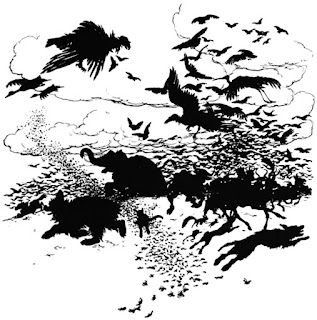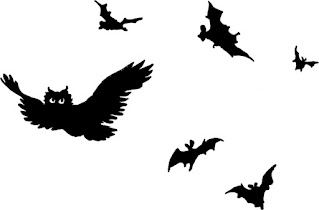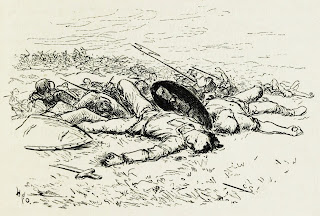As part of a creature project, I'm taking a look at improving the 'swarm of creatures' mechanics in Fifth Edition Dungeons & Dragons.
The problem is one of verisimilitude balanced against the quirks of the 5e combat system, and a desire to make swarms uniquely vulnerable to the things they should be vulnerable to while dangerous if you're fighting them without those things. Only fun solutions are allowed!
What are the essential characteristics of a swarm?
A swarm of creatures is a notable opponent because each of its diminutive components is, almost by definition, (a) mostly harmless and (b) trivially defeated. Only en mass are they dangerous and require effort to destroy.
Characteristic 1: Weapons shouldn't matter, but strategies might
A lot of TTRPGs massively undersell the killing power of a bladed weapon compared to a blunt strike in almost all situations. One exception is fighting a swarm.
Typical swarms are made from creatures so small that the more effective approach to fighting them would be to hit them with something broad, in order to crush as many as possible at a time. If you have six seconds to spend and you're fighting a homogenous area of a thousand flying bugs in the space in front and to the sides of you, then we can imagine shooting an arrow might kill ~0.5% of the swarm if you're lucky, swinging a razor-sharp blade could kill ~1%, and swinging an ordinary dining chair could kill ~5%. If they're ground-based creatures, stamping on them or rolling around on them are likely to be far better strategies than swinging a weapon.
So if a player character wants to fight a swarm, then we only have to consider whether they're in melee or shooting at range; to simplify we might generously allow melee weapons to be as effective as unarmed or improvised attacks, so that players don't feel silly just having their characters stamp up and down every turn. Ranged attacks should be much worse, though.
As the swarm's component creatures become larger and more dangerous, the martial skill and physical power of the person fighting them might begin to matter. But for heroic fantasy like D&D 5e, I think we would generalise 'fighting skill and power' to 'character level': CR 18 swarms should be made up of individual creatures of a kind that any 18th level character can destroy trivially and in quick succession in a fight; the same creatures might individually pose a small challenge to 1st level characters, but the 5e design parameter of bounded accuracy limits the degree to which this can be true.
Characteristic 2: Big, flowing, and diffuse
A swarm is made of tiny little freely-moving elements, and therefore behaves something like a fluid: it can get into small spaces, surround creatures, and so on. Healing, strengthening, or weakening an individual creature shouldn't have any impact on the swarm.
How large and dense is a swarm of animals? Dense enough to see it clearly, as a bare minimum. In practise, I think it would be more viscerally horrible if it's really dense, with creatures crawling all over each other.
- As a bare minimum density, I think we should imagine at least one flying bug in every 4×4×4 cm cube. Then we would have more than 15,500 bugs in a cubic metre, which is about the space you could swing a chair through.
- Alternatively, we can imagine one larger flying creature like a small bird or bat in each 25×25×25 cm cube. There would be 64 such creatures in a cubic metre.
- For a dense mass of beetles crawling over each other on the ground, we need at least one beetle every 2×2 cm. Then we would have at least 2500 bugs in a square metre.
- Likewise, for rats or tarantulas or other larger creatures, I would expect at least one animal every 10×10 cm, for at least a hundred critters in a square metre.
I envisage swarms as having a big dangerous centre part and a much less dense 'periphery' of creatures that continually enter and leave the centre, but are mostly harmless. We can think of the swarm as being all the creature in it, but it's mostly the ones in the core attacking and grouped up in ways that makes it possible to kill them at any reasonable rate.
When I sit back and imagine a swarm, the whole thing must be at least five square metres on the ground, or at least ten cubic metres if flying – preferably much larger. Anything smaller seems pitifully small. Of that, the dangerous core is maybe a fifth to a half of its area (or volume).
This back-of-the-napkin maths implies you're fighting ~150,000 wasps or ~640 bats or ~12,500 centipedes or ~500 rats.
It's a good place for a reality check. Here on Earth...
- A bat colony has several hundred bats
- A honeybee swarm has 5,000 to 40,000 bees
- A murmuration of starlings has 5,000 to 50,000 birds
- Army ants form swarms or columns of between 200,000 and 20 million ants
- A desert locust swarm is pretty diffuse, with 'only' 50 to 70 locusts per square metre but covering hundreds of square kilometres in total
Real-world swarms are probably much less dense than the ravenous fantasy swarms we imagine. But whether they are or aren't, the numbers don't seem off by multiple orders of magnitude.
Characteristic 3: Time required for attrition
Assuming a swarm is only dangerous because it is a very large group of marginally dangerous creatures, it should take a long time to destroy in melee combat.
If you have a six-second turn, maybe you can completely destroy half a cubic metre of flying creatures by swinging a chair through them, or annihilate a quarter of a square metre of ground-based creatures by jumping up and down on them. I actually think that's generous even for characters in a heroic fantasy genre.
Then with the parameters we've established it should take a minimum of 20 character turns to kill a swarm in melee (as a level-appropriate moderate challenge, 5 rounds for a party of four characters). For the kind of bigger, more dense swarms that we'd prefer, it 'should' take much longer to destroy a swarm without something that takes out a huge chunk out of it at once (see Characteristic 8, below).
Characteristic 4: Easy to hit
It shouldn't really be possible to try to harm a swarm and fail.
It doesn't matter if you're swinging an axe at bats or stamping on centipedes, we're talking about a packed area of low-intelligence creatures with little situational awareness, a flocking instinct, possibly driven into a frenzy, and surrounding their enemies on all sides. They're not getting out of the way.
In D&D terms, it shouldn't require an attack roll to take a swing at a swarm, and they should at least have disadvantage on most saving throws.
Characteristic 5: Dangerous in numbers
A swarm should be able to attack almost indiscriminately. Ideally, anything inside it should get hit; we might limit this to a 'multiattack' to make it faster.
As a swarm gets smaller, the amount of harm it can do should fall.
- If a swarm takes up less volume as it suffers attrition, keeping the same density, then the number of targets it can attack simultaneously goes down.
- If a swarm takes up the same volume as it is attrited, its density falling instead, then the amount of harm it does to each target goes down.
- If a swarm's volume and density are both reduced, then you could justify either option.
Characteristic 6: A reason for cohesion
The main reason (on Earth) that animals band together in swarm is to defend against predators. There's both 'safety in numbers' in the sense of an individual becoming statistically less likely to be predated, but also, the movements of the group can confuse or in some cases intimidate predators. There are rare exceptions, like army ants, which seem dangerous because they group up to hunt. I think it's safe to say that fantasy swarms are more like the latter.
A swarm sticks together, but clearly doesn't have to – its individual components aren't physically connected. It's a matter of taste as to whether parts that get separated can rejoin the swarm to continue acting in unison; I would rule that they can.
A swarm also can't react quickly or precisely or perform complex tasks, and its individual creatures attack pretty much blindly. In D&D terms, I wouldn't let it make attacks of opportunity: if you're in the swarm, you're being constantly bitten (with lots of miniscule harm adding up to HP worth of damage), and if you're not, you're not. If anything, a creature should suffer less harm for leaving the swarm's area sooner, but that's difficult to reconcile with D&D mechanics for only a small payoff.
Something is motivating the swarm to act as if it were a single creature. Maybe...
- A true hive-mind has emerged from the swarm, or
- A foreign overmind is controlling it, or
- There's some spell or fantastical natural force in play, or
- The individual creatures have a psychic bond
It seems likely that forcibly disrupting the swarm's cohesion would be particularly harmful to it. Depending on the nature of the outside motivator, the swarm might be particularly vulnerable to psychic damage, or it might shrug it off completely. I personally favour the former.
Things that affect a creature's physical body (conditions like paralysis, poison, and petrification) probably only affect one or a small number of bodies within the swarm, for negligible effect. We could model this as the minimum unit of harm in D&D, 1 hit point loss.
Characteristic 7: Extreme susceptibility to area damage
A little creatures which is individually below notice can be killed instantly by almost any attack. Some attacks are indiscriminate, hitting everything in an area. Even a really dense swarm probably has some room between creatures for such effects to penetrate.
It follows that effects like fire, force waves, toxic or corrosive clouds, rough weather, etc should do massive damage to a swarm. A swarm caught entirely within such an effect might struggle to survive at all! In D&D terms, it is not sufficient to model these kinds of things as different damage types. "6d6 poison damage to any creature in the cloud of poison" should kill a swarm; "6d6 poison damage to a creature hit by the arrow" should barely inconvenience it.
So does 5e capture these essential characteristics?
Not sufficiently, although the writers made an effort in that direction. Consider the six swarms in the D&D 5e System Reference Document (SRD).
Characteristic 1: Weapons shouldn't matter, but strategies might
Characteristic 7: Extreme susceptibility to area damage
✅ SRD swarms do resist the kind of damage usually associated with weapons.
❌ ...But on average a longbow will still do more damage than a club, which will still do more damage than fists and feet, i.e., the opposite of what we'd expect.
❌ More martially skilled characters deal substantially more damage than less martially skilled characters when smacking at a SRD swarm in their space. We wouldn't expect this, especially at low levels (where flailing around with something broad and heavy to crush dozens or hundreds will always be a good strategy).
✅ SRD swarms don't resist any of the classic area spell damage types, making damage spells a good choice against them.
❌ ...But nor do they resist single-target spell damage. And if an area spell does deal weapon-like damage, an SRD swarm takes half damage from it (which it really shouldn't).
Characteristic 2: Big, flowing, and diffuse
✅ The SRD absolutely nails the 'Swarm' trait. I don't think it needs to change at all.
❌ The SRD swarms are Medium in size. Even if we imagine this as the most dense centre part of the swarm, this still feels too small for any but the absolute weakest of swarms (admittedly all the SRD swarms have a low CR).
Characteristic 3: Time required for attrition
Characteristic 4: Easy to hit
❌ The SRD swarms have similar HP to comparable SRD monsters, but their resistances effectively double it. However, their HP is unremarkable per the DMG monster creation rules, even factoring in resistances. They should be harder to destroy using single-target attacks.
❌ Likewise, their AC is typical for their Challenge Ratings, so a fair number of attacks (at least a third) will just miss them, even though that makes no sense.
Characteristic 5: Dangerous in numbers
✅ The SRD swarms lose half their damage output when reduced below half health, calling to mind 4e's Bloodied condition. I think only changing it one time at half HP is reasonable. It means a swarm's current number of component creatures is directly reflected in its damage, but doesn't create more mental load for the GM with a more complex way of doing that.
❌ To have a SRD swarm attack lots of creatures at once, the GM has to fake it by using multiple swarms together. Really a swarm should be larger and dangerous to anything inside it. Think about the verb form of the word 'swarm'.
Characteristic 6: A reason for cohesion
✅ SRD swarms are immune to most conditions, as we would expect. There are some edge cases like blinded, deafened, and poisoned which the designers let affect them (the first one possibly due to how light and obscuration are defined).
❌ Swarms probably shouldn't distinguish 'attacks of opportunity' from just continually attacking. Also, SRD swarms are affected normally by psychic damage despite being made up of hundreds or thousands of minds.
Evolution of solutions
When I initially wrote a more plausible 5e swarm based on that analysis, playtesting showed that I'd gone too far in the direction of realism. The fun was being lost.
Swarms could be blown up by quite low level spells, and a combat run strictly with melee attacks was a grind: arduous but not very dangerous.
In 5e, combats that go beyond three rounds are uncommon, ones that go beyond four rounds are rare, and so on. When the four PCs took six rounds to destroy just one of three lower-CR swarms I knew I'd miscalculated. Out of a sense of morbid curiosity, I gamed out eleven(!) more rounds before the fight was over.
Fortunately, I found some tweaks that solved this:
- Harmful area effects should do a lot of extra damage to
a swarm (especially if all of it is in the area) without completely
trivialising an encounter.
- A melee attacker can't waste every turn inflicting really trivial damage on a swarm. (It's fine to make single-target ranged attacks useless, because 5e has no strictly ranged glass cannons, and the character types that come near that all have access to area damage.)
- Swarms can have middling damage that drops when they hit half HP, as long as they deal some small damage on a miss, for an effect akin to a damaging aura.
With these changes, fights using just one or two spells last a good number of rounds. Multiple spellcasters willing to expend their best spell slot in their first turn can destroy swarms easily if they want to pay that cost. Fights with mostly mundane combat go longer than normal, but not outrageously so. More importantly, damage-on-miss makes swarms feel dangerous; between that and 'you can't fail to hit a swarm', the two sides are continually wearing each other down.
The final stat block isn't as completely verisimilitudinous as my initial vision, but overall it's a fun challenge to fight with a reward for thoughtful play, which is important. And the other changes to the SRD 'swarm' type monster implied by this article's analysis all worked well, so they'll be included in the final write-up.
Of course, to make this all hang together, the modified swarm needs a large number of traits (as well as some slightly unusual stat block entries like damage-on-miss and broad spectrum condition immunities). That's a no-no; it imposes substantial cognitive load on the GM, especially a GM trying to use it on the fly.
The next step, then, will be a challenge: Edit the text into a shorter form which presents the most important information in a way that's easy to find while keeping the writing crisp and clear. But isn't that always the case?





















